Posted by Steve Price on 08-24-2002 09:07 AM:
Did the engsi hang inside or outside the yurt?
Hi People,
Here's a photo of a Kazakh yurt, taken in
1937.

The engsi is clearly shown, rolled up at the entrance. If
you look carefully, you can see that the roll is halfway in and halfway out of
the yurt, so when it was unrolled, the edges of the engsi would have abutted
the edges of the felt outer covering of ther tent. That is, it was neither
inside nor outside, just as the door of a modern house is neither inside nor
outside.
The source of the photo is Peter the Great's Museum of
Anthropology and Ethnography, St. Petersburg. I scanned it from Nomads of
Eurasia (Basilov and Zirin, eds), p. 99.
Regards,
Steve
Price
Posted by Robert Alimi on 08-25-2002 10:33 AM:
Hi Steve,
Here are some additional images. As I recall, these
photos were taken around 1910.

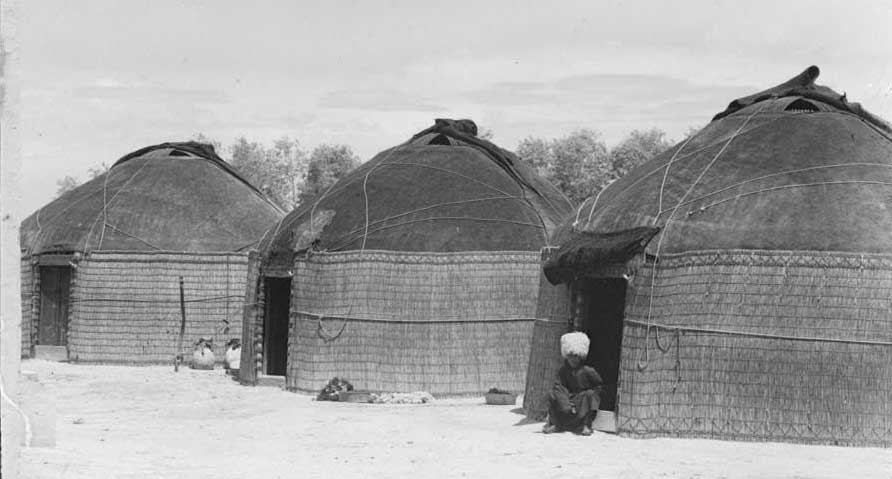

From the images, it appears that these engsis hang
outside the doorframes. Although it's really hard to tell from the photos, 2
photos appear to contain pile weavings, while 1 photo contains a textile that
is felt work.
Regards,
-Bob
Posted by Yon Bard on
08-25-2002 11:22 AM:
Bob, any info on where these photos are from?
It is noteworthy
that while Steve's ensi fits neatly in the door, Bob's are just slung from the
roof and don't need to obey any strict size constraints.
Regards,
Yon
Posted by Robert Alimi on 08-25-2002 06:58 PM:
Hi Yon,
I'm pretty sure that these photos are part of the
Prokudin-Gorskii Collection from the Library of Congress. I had saved these
images to my own computer some months back. I can't put my finger on the
specific source URL just now, but a starting link is:
http://frontiers.loc.gov/intldl/mtfhtml/mfdigcol/aboutpg.html
As
I recall, the photos are just tagged as "Central Asia", without any specific
information for each photo.
-Bob
Posted by Kenneth Thompson
on 08-25-2002 10:14 PM:
Dear All,
From all that has been said and written, it seems safe
to say that the Ensi (or at least a door flap of whatever name) hung on the
outside of the oy or yurt. The second picture that Bob posted is the first that
I have seen that may show a pile door flap. Every other instance that I have
found has shown a felt door flap, but these have been almost always on Kirghiz
or Kazakh dwellings. The Kirghiz equivalent seems to have been the Eshiktish
which by derivation was hung outside the oy. (Eshik=threshold, tish (or
dish)=outside.) Given the special nature of pile carpets, it seems unlikely
that a pile ensi would have been a permanent fixture on the outside of
structure exposed to harsh weather. It would make sense for it to be a special
occasion piece put up to welcome a bride or important visitor.
Another
possibility: could there have been two door flaps, a felt one on the exterior
and another interior one hung for special occasions? Or used as a tent divider
on special occasions? Any ithoughts?
Best regards,
Ken
Posted by Robert_Alimi on 08-26-2002 03:12 AM:
For what it's worth, I was able to locate the original images at the
Library of Congress website. I downloaded the (very large) tiff files and have
cropped the photos to focus on the doorways. Here are the close-up
images:
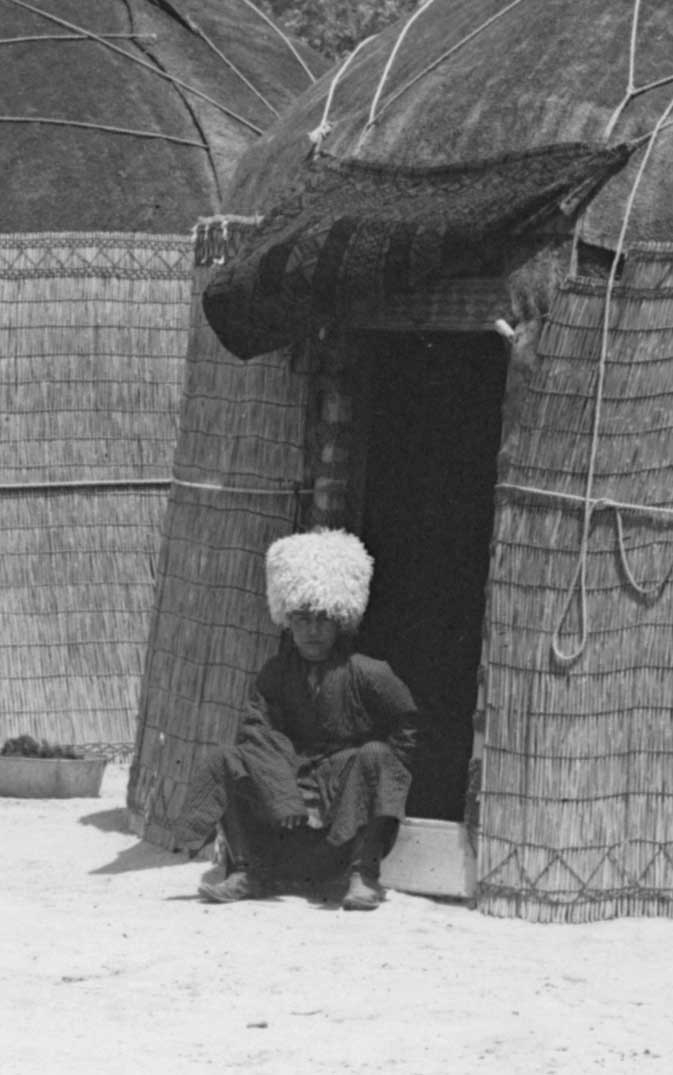
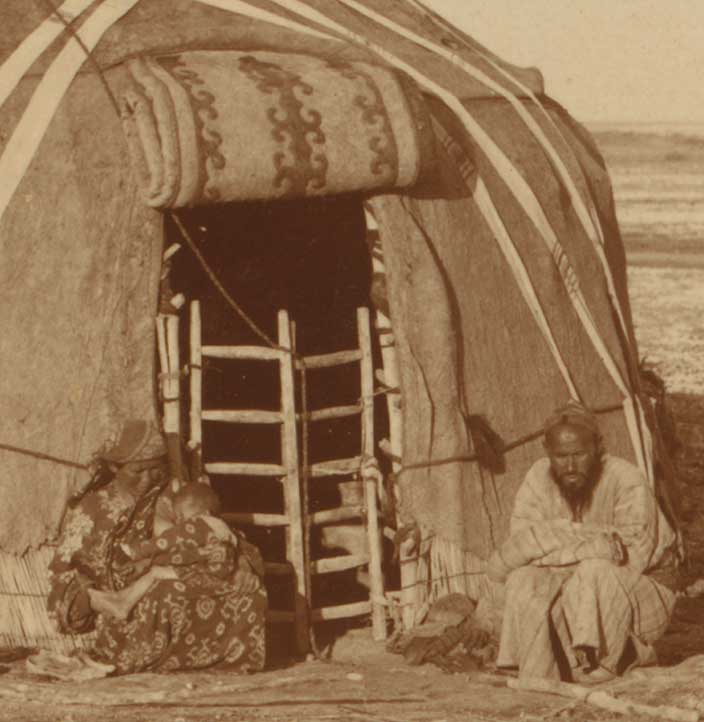
-Bob
Posted by Filiberto Boncompagni on
08-26-2002 06:21 AM:
Thanks for the pictures, Bob.
The door flap in the first close-up
looks definitely a pile weaving.
One should suppose that during daytime
the engsi was kept in that way.
One should thus expect engsis having the
upper part more discolored by sunlight…
This doesn’t seems the
case - unless collectors’ engsis where never used or had very fast colors.

Regards,
Filiberto
Posted by Steve Price on 08-26-2002
06:30 AM:
Hi Filiberto,
Actually, if the ensi was kept rolled up or folded
above the doorway during the day, it's the back that would fade from
light exposure; specifically, the part of the back that was outermost when
rolled up (the area near the bottom of the ensi). Sadly, few photos of ensis in
exhibitions, books, auction catalogs or magazine articles show the backs.
Regards,
Steve Price
Posted by Filiberto Boncompagni
on 08-26-2002 08:08 AM:
Hi Steve,
It depends on how the engsi is rolled up.
The ones
in the above pictures seem rolled UNDER the front.
I mean, for the pile one:
it seems the lower part was rolled under the upper one with the pile facing
outward.
The same for the felt: what we see is the front face, not the
back.
In any way, one side should be more sun-faded!
Perhaps, as Kenneth
wrote, they were used only in special
occasions.
Regards,
Filiberto
Posted by Steve Price on
08-26-2002 10:24 AM:
Hi Filiberto,
You're right. I hadn't noticed that. In any case,
if they were used regularly, there ought to be a faded horizontal band in the
place that was exposed.
Regards,
Steve Price
Posted
by Robert Anderson on 08-28-2002 01:13 PM:
It’s difficult for me to see from the pictures, but nothing in them
looks like a typical engsi-format rug. The last photo clearly shows a felt (or
a rug with a felt design) and the next to last photo shows what may actually be
a pile rug, attached to the outside of the tent with ropes and slung up and
over the top of the doorway. However, it looks wider than the doorway to me, so
maybe John’s idea that engsis should fit within the doorway, or perhaps be
a bit narrower isn’t valid.
As a person with a scientific bent, I
can appreciate any attempts to analyze engsis and other rugs using available
data. However, trying to do this with data obtained from books and other
second-hand sources is, in and of itself, risky. For example, how accurately
were the measurements made? Could there have been transcription errors in the
proof or in printing? How about pieces that are fragmented or reduced in length
at either end due to wear, which may include some of the oldest and most
interesting engsis? With this caution aside, I would like to make a suggestion.
Rather than presenting the averages of the length to width ratio (or similar
data) from engsis assigned to the different tribes, it might be more
illustrative to plot these data together on graph paper, for example, length on
the vertical axis vs. width on the horizontal axis. (Pinner and Frances in fact
did such an analysis of Turkoman tent bags. See ‘Tent bags and simple
statistics’, Turkoman Studies I). Then, any obvious clustering would
become apparent, which might otherwise be “blurred” by averaging. For
example, it might turn out that a subset of Tekke engsis lie outside of the
main Tekke group and much closer to the Salors. Another possibility is that
old-appearing engsis might tend to cluster together. This might occur, for
example, if engsis evolved from a common ancestral type. One problem here is
that there is not much agreement when it comes to estimating the age of rugs,
although characteristics like wool quality, dye usage and colors, and even
aesthetic judgments might have some usefulness. Also, how far back must we go
to a prototype, if in fact one ever existed? Two hundred years? A thousand
years?
What can be argued with a fair amount of certainty is that most
surviving engsis date from the commercial period, after around 1880 when the
Russian military and traders already occupied the region. As an aside, it is
unfortunate that more of these early visitors were not professional
ethnographers or anthropologists by today’s standards, which probably led
to the loss of much valuable information. In any event, the resulting social
unrest and commercial pressures were undoubtedly important factors for change,
perhaps causing engsis to rapidly evolve from whatever function(s) they once
had, finally into decorative throw rugs for the Western market. Therefore, we
should probably eliminate obviously late-appearing engsis (certainly ones with
synthetic dyes or eclectic designs, etc.) from our analyses, including many
Tekke, Yomut, Ersari, and even Saryk examples. So, now we are left primarily
with engsis from the Salor (a tribe that declined as a result of military
defeat before the commercial period), the Arabatchi (a small tribe that may not
have felt much commercial pressure), the Chodor (to a lesser extent), and a few
isolated tribal groups, a VERY small database of potentially
“authentic” engsis with which to work. Even the Salor may have led a
settled or semi-nomadic existence for a long time prior to their defeat, and
arguably engsis made by settled groups might have served a different function
than those made by nomads.
So what WERE engsis originally used for? The
most common proposal is that they were tent door rugs. However, several
arguments have already been made against this idea, which can be summarized as
follows: 1) the lack of expected weathering and fading on many examples thought
to be old; 2) the existence of few really convincing pictures of engsis in use
– most pictures show felts, or possibly pile rugs of indeterminate design
and size; 3) just as most engsis are bigger than the average prayer rug, most
seem to be too small for door rug use, whether or not they were hung inside or
outside the yurt entrance; 4) the use of an accessory germach to increase the
length is possible, but germachs seem to be much rarer than engsis with only
Tekke and very rare Arabatchi examples known, and 5) as opposed to thick, heavy
felts, most engsis would serve as poor barriers to the cold and wind. Some
believe that engsis were used only for certain festive occasions, such as
weddings, and that most of the time they were stored away with other dowry
goods. I sort of like this idea. Many believe experts that the majority of the
engsis surviving today are commercial products resulting from Western demand,
or that they were made as part of the prescribed dowry long after they ceased
having any utilitarian function. These ideas also seem plausible. Speculation
by some that engsis were used in a totem-like fashion (i.e., to denote clan or
social status) or that they were used in religious (e.g., shamanistic) rituals
are intriguing but cannot be supported with any evidence.
So where to
go from here? It is unlikely that the engsi format arose in isolation. So one
tack might be to look for it and associated design elements in old rugs (and
art forms) from other cultures and tribal groups, both inside and outside of
Western Turkestan. As was proposed in a post from another thread in this Salon,
compartmented rugs might be a starting point, specifically, compartment rugs
from Turkey; also, the garden carpets from Iran, and a possible analogue to the
four-square hatchli format seen in an old rug from East Turkestan (see
Schurmann, Central Asian Rugs, plate 90). Even rugs not organized into
compartments could be looked at for their shared design motifs and similar
structural features. Although the original meanings and significance of the
motifs and design elements used in Turkoman engsis and other rugs may never be
known, the Turkoman women appear to have had names for many of them (see
Tzareva, Rugs and carpets from Central Asia). Perhaps not surprisingly, these
names appear to be have been based upon the motifs’ resemblance to common
animate and inanimate objects found in everyday life. Religion with its
associated mystical and spiritual aspects undoubtedly played an important role
in Turkoman life, however, reality was comparatively harsh and the main
preoccupation would have been with obtaining the corporeal necessities. Thus,
the ‘kejebe’ (wedding litter on the camel) motif seen on some
Turkoman engsis (also the more explicit depiction of the wedding caravan on the
elem of Arabatchi engsis) may express hope for material wealth, a good marriage
and many children. The ‘kush’ (bird) motif perhaps symbolized birds
of pray and therefore success in the hunt (but see also, Neergaard,
‘Turkmen tent band figures used as design elements on carpets and
bags’, Oriental Carpet and Textile Studies, Volume 5(1), where it is
proposed that similar design forms are intended to represent ‘Toyon
Kogor’, “the lord of the birds and ruler of earth and sky”).
Other ornaments may have been used to “ward off the evil eye”,
ensuring health and prosperity. Whether we ever know the purpose for which
these rugs were made or the meanings of their designs, they will remain for me
a source of great fascination.
Robert Anderson
Posted by
Marla Mallett on 08-28-2002 11:13 PM:
Hung How?
Hi Folks,
I’m curious to know what evidence anyone has
found in the way of damage at the upper corners of their ensis…or what
evidence of any attached hanging apparatus has been found… Just imagine
the stress on any weaving hung from only a couple of points and then repeatedly
jerked around.
Marla
Posted by R._John_Howe on 08-29-2002
05:48 AM:
Correct Attribution
Dear folks -
I need to correct one indication by Mr. Anderson in
the immediately preceding post.
The notion that width of engsis might be
important was not my idea but rather one that occurred to Peter Andrews as he
considered the Ersari lady's indication that in her experience (she is likely
in her 50s) engsis were placed on the inside of the tent door.
Mr.
Andrews as some of us know, is probably the world's foremost scholar on such
tents having published in 1997 a very scholarly two volumes entitled: "Nomad
Tent Types in the Middle East."
Peter has promised to look to see if the
"scores" of Yomut tent door widths he recorded in the 1970s in the field are
locate-able. But it was his suggestion that most Turkmen tent doors are likely
120 cm or narrower.
Tomorrow I will give you a long quote from these two
volumes in which he discusses the "door flap" for a typical Yomut trellis
tent.
Regards,
R. John Howe
Posted by Steve Price on
08-29-2002 05:52 AM:
Torn Corners
Hi Marla,
I've seen a number of ensis with the upper corners
torn, I assume from the stress of being hung from them. Same for some juvals
and torbas.
Regards,
Steve Price
Posted by Filiberto
Boncompagni on 08-29-2002 06:40 AM:
Hi Marla,
Right.
Jourdan’s plates 57 and 58 show two
Tekke ensis with "hanging apparatuses" - the first one looks positively
original.
Also another Tekke "Door Hanging ensi, 133x181cm" from the catalog
of 1993 Genoa Exhibition "Carpets of Central Asian Nomads, has "At the corners,
small woven and pile rectangles folded to form a point with 55 cm long plaited
warps". The exhibition was organized by Elena Tsareva and showed almost the
same pieces of Dudin’s exhibition on ORR web site.
I can post the scan,
if you want.
Robert, congratulations for your comprehensive
posting!
Regards,
Filiberto
Posted by R. John Howe on
08-29-2002 12:13 PM:
Andrews Quote
Quote from Peter Andrews’ Volumes
Dear folks
–
Here, below, is the long quote I promised you from Peter Andrews
volumes on “Nomad Tents in the Middle East.” This quote if from Part
I, Framed Tents, Volume I, page 67. It is headed “Tellis tent: Turkmen of
Iran: Yomut and Goklen.”
But first, for context, here are two of
the beautiful drawings of the sample Yomut trellis tent that Andrews provides
in Volume II. These drawings are to scale based on Andrew measurements. The
first two are by Susan Calverley. The third is by Andrews’ wife, Mugul,
who is also a rug scholar, part Turkman by heritage, and who accompanied him in
the field.
This first drawing is of the “Tent frame with
cordage.”
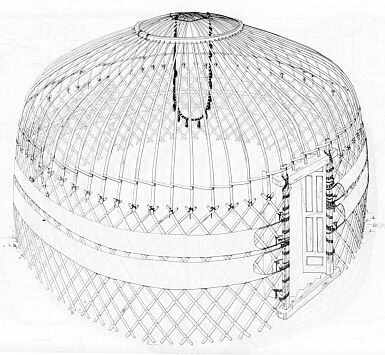
The second drawing is labeled
“Perspective of complete tent showing felt ties.”
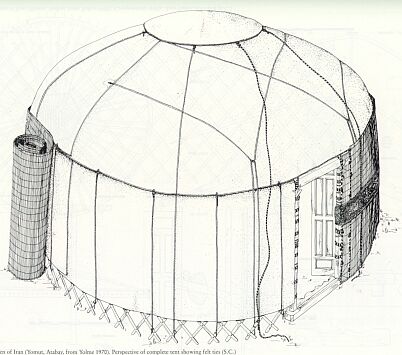
This is the text section headed “Door
flap:”
“…informants claimed that until 1920s the usual
door was a felt flap rather than the wooden door leaves usual nowadays. The
flap was still seen occasionally in 1970-74. The outer felt face is backed by a
mat of canes held horizontally and bound with vertical goat hair lines: this
allows the flap to be rolled up, still with the felt face outward, in such a
way that it will remain in place at the lintel, held by friction and its own
weight, when the doorway is open. It is made 110-120 cm wide to overlap the
doorposts and the front edges of the wall felts on either side, and 185-230 cm
long. The canes are 1m. long, and usually split in half before being bound, all
facing the same way, with 8 goat-hair lines spun S of 2 or 3Z passed around
each in turn at 10-13 cm intervals. They are then laid cut side downwards on
the felt, and the edges of the felt turned over their ends along the long sides
and at the bottom before being sewn down, forming an edge 3-7 cm wide. The top
part of the flap reaching from the level of the lintel upwards is tapered so
that it can be inserted easily under the edge of the front roof felts: it
varies in width at the end from 55-88 cm and in length from 18-66 cm. Ties are
provided at each of the top corners, and sometimes at the top centre. Where the
tapering upper tongue is long, a pair of ties may also be provided at the top
of the rectangular part: these can then be attached to the the top of the door
posts horns, about 10 cm above the lintel. These may be of black and while
plaits. Another set of ties is provided lower down for securing the flap at
night. The felt face is usually decorated with scrolled branching patterns of
colored wool laid in while fulling. This is the only instance in which the felt
tents themselves are coloured. The former importance of the door flap is still
indicated in the way in which the top corners of the cane screen are invariably
cut back on either side of the doorway to allow its insertion. The unique Yomut
name of the flap, “tarp yapar,” indicates the sound with which it
closes “with a clap,” or its speed, “in a wink.” Among the
Goklen it is called the “is ensi.”
In the example, the flap is
110 cm wide at the bottom, narrowing slightly to 106 cm at the lintel and then
more sharply over 18 cm to 88 cm at the top; the full length is 185 cm. There
are eight goat hair binding lines on the canework, both no leather strips, and
the felt edge is folded over for 3 cm only. There are three ties at the top
end, 65-75 cm long, in triple plaits of goat hair yarn, plied S of three
Z.”
Here are the drawings of the “door flap” from Volume
II.
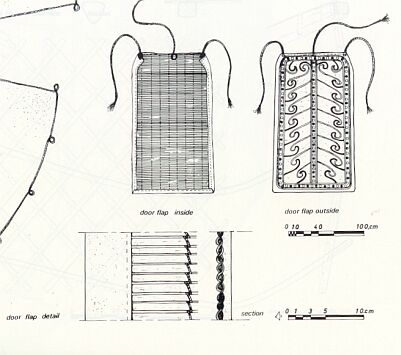
Now, of course, this is all about a felt door
flap, but it gives a concrete picture of the logic that guided its size and
shape. I also provide this passage just to give you an example of the
meticulous description that Peter Andrews provides in these two
volumes.
One thing to be noticed about this door flap is that it is much
more a “length twice the width” shape than are most
“engis,” which at about 4 feet wide by 5 feet long are more nearly
square.
Regards,
R. John Howe
Posted by Yon Bard on
08-29-2002 01:46 PM:
Marla, I have a Tekke ensi with hanging ropes attached to the top
corners.
Regards, Yon
Posted by Robert Anderson on
08-29-2002 04:41 PM:
Thanks for the illustrations John. Then the door flap is a
cane-reinforced felt about 6 to 7.5 feet long and 4 feet wide so as to overlap
the doorposts? Sounds like a fairly sturdy arrangement, well insulated against
the cold and strong enough to withstand the wind. Most engsis are smaller than
this. So, unless tent doors were also smaller in times past, it would appear
that the engsi was never intended to be a functional door cover.
Robert
Anderson
Posted by Marvin Amstey on 08-29-2002 05:15 PM:
My Ersari engsi has the same corner ropes as seen here. But I believe
Marla's point that the continued wear and stress would pull them off. This
particular piece was probably not used. Interestingly, I had a Yomud main
carpet with the same braided ropes in each corner that I guessed were used for
pulling the rug over some goods and tying it down on a camel, elephant or
pickup truck.
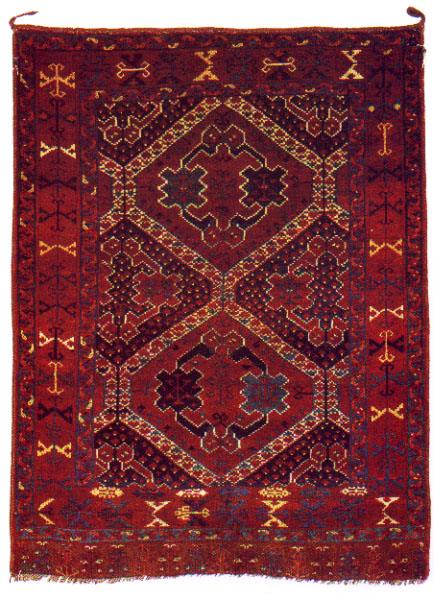
Best regards
Posted by
Patrick Weiler on 08-30-2002 09:57 AM:
Tie One On
Here is another Turkmen trapping with tie ropes. (I do not remember the
source of this photo)
This one has them at what are usually called "closure
marks", the small, blue "V" shapes just below where the ropes are attached.
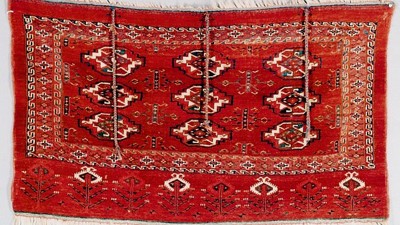
I do not recall seeing many of these bags with
"stretch-marks" or wear at the points assiciated with these rope attachment
points, but it may be that the entire top several rows of the bags were cut off
when they were prepared for sale, so any distress to these areas would have
been removed.
It may well also be that the engsi and many bags like this
one were not "used up", but kept as dowry keepsakes. Another idea regarding
engsi's is the likelihood that they were used inside the tent to separate an
area - possibly that of newlyweds from the rest of the tent. (the so-called
"door to Paradise"?
 )
)
This would have minimized the wear one would associate with use as a tent
door.
Patrick Weiler
Posted by Yon Bard on 08-30-2002 10:56
AM:
Patrick, very interesting! This is the first confirmation I have ever
seen that the 'closure marks' were actually closure marks! This example,
however, does not appear to be analogous to the hanging ropes that appear at
the top corners of many asmalyks, torbas, and ensis. Btw, looking again at some
of my ensis, I noticed damage to the upper corners in some of them that I
hadn't paid any attention to before. There is little doubt that many ensis were
designed to be hung from their top corners and not tucked into door flaps as
suggested by Andrews. Anyway, the wide variation in ensi sizes suggests that
they were not as a rule meant to fit exactly into a confined
frame.
Regards, Yon
Posted by Chuck Wagner on 08-30-2002
07:27 PM:
A quick note
Greetings all,
Several months ago, during the Tent Pole Cover
salon, we got onto the topic of ensis, and I'd like to repost a couple of the
text blocks here because we agreed to wait until this salon came along before
continuing. We got to the ensi part by digressing away from a discussion on
Turkoman weddings.
--Block 1-:
In Afghanistan and Pakistan,
"ensis" are called "purdahs". Purdah (pardah) is the term used to describe the
generally Islamic phenomena of separating women from the world of the men. Some
refer to it as lifelong prison and slavery. The men, on the other hand, do not.
Regardless, I propose the reason that we have no photos of ensis being
used as tent/oy doors is because they weren't used as tent/oy doors. I think
that they were used as doors for internal dividers within the tents/oys that
separated the womens space (or private adult space) from other areas within the
tent/oy. They may well be the bridal curtain, which could explain the very
special, and entirely different appearance, that ensis have compared to other
Turkoman weavings.
I think this because of 1) the liguistic connection,
2) because the dimensions of ensis and purdahs are consistent with the larger
Kirghiz reed screen dividers, and 3) because the looped hanging straps (that
I've seen in photos) are just right for hanging on a line strung across the
interior of a stick frame oy.
--End Block 1--
Now, a couple of
the photos in this salon do look like they captured pile weavings used as door
flaps, so my comment about "no photos" is no longer reasonable. I will say that
none of the images are DEFINITIVE with regard to the classic ensi designs we
see, but one in particular is quite close.
Steve continued to bait us
regarding ensis in the Tent Pole Cover salon, so I added this next block
later:
--Block 2 --
OK Steve. I'll add a little something to
the things-to-consider heap, but mainly to get it on the record because I can't
be assured of having the book or a working computer later on. We'll discuss the
picture later, when John is ready.
I have laid hands on a book entitled
"A Journey to the Source of the River Oxus", by Capt. John Wood, Indian Navy
(Reprint: Oxford University Press, Karachi, 1976). Capt. Wood took a 3000 mile
excursion up the Indus to the upper reaches of the Pamirs in 1836. No
illustrations but a couple of nice maps. His attention to detail is remarkable.
He visited a Kirghiz encampment, and the following are some excerpts
from his text (he wasn't one for small paragraphs):
"We now asked
permission to rest awhile in one of their kirgahs, and were immediately led up
to one of the best in the encampment. Its outside covering was formed of coarse
dun-coloured felts, held down by two broad white belts about five feet above
the ground. To these the dome or roof was secured by diagonal bands, while the
felts which formed the walls were strengthened by other bands, which descended
in a zig-zag direction between those first mentioned and the ground. Close to
the door lay a bag filled with ice-the water of the family. On drawing aside
the felt which screened the entrance, the air of tidiness and comfort that met
our eyes was a most agreeable surprise. In the middle of the floor, upon a
light iron tripod, stood a huge Russian cauldron, beneath which glowed a
cheerful fire, which a ruddy-cheeked, spruce damsel kept feeding with fuel, and
occasionally throwing a lump of ice into her cookery."
----text---
"The kirgah had a diameter of fourteen feet, a height of eight, and was
well lighted by a circular hole above the fireplace. Its frame-work was of the
willow-tree, but between it and the felt covering, neat mats, made of reeds,
the size of wheat-straw, and knitted over with coloured worsted, were inserted.
The sides of the tent, lined with variegated mats of this description, not only
looked tasteful, but imparted a snug and warm appearance to the interior.
Corresponding to the outside belts were two within of a finer description, and
adorned with needle-work. From these were suspended various articles
appertaining to the tent and to the field, besides those of ornament and the
sampler. Saddles, bridles, rings, thimbles, and beads, all had here their
appropriate places. One side of the kirgah had the family's spare clothes and
bedding. In another, a home-made carpet hung from the roof, making a recess in
which the females dressed, and where the matron kept her culinary stores and
kitchen apparatus. The opposite segment was allotted to the young lambs of the
flock. A string crossed the tent to which about fifty nooses, twenty-five of a
side, were attached, to each of which a lamb was fastened."
--- End of
quotes ---
Lots of information in there, and I'm wondering if the
carpet mentioned might have been an engsi .
--End Block 2
--
I'll add a comment at this point: It seems to me that most of the
ensis in existence today are actually in pretty good condition, and I think
this adds credibility to the notion that many ensis were used as interior
dividers. Wouldn't a piece used as an exterior flap show significant evidence
of exposure to the elements, and have substantial distortion at fold and hinge
points ?
Regardez: How many felt door covers survive today ? (Captain
Wood is careful to note that the door flap is felt but the interior wall is a
home-made carpet.)
Further, I doubt that it's just a coincidence that
the Afghanis and Pakistanis refer to these pieces as purdahs. There must be a
cultural connection there.
I'll leave it there for now; I'm travelling
and it may be a couple days before I can get back to respond to additional
comments.
Regards, Chuck
(p.s. If this salon is still going when
I get back to my home computer, I'll post a couple scans of illustrations from
another old book)
Posted by Kenneth Thompson on 08-30-2002 11:05
PM:
Pile or Felt Doorflap in Photo
Dear All,
I have been looking more closely at the photograph that
seems to show a pile ensi. Since this would be the first time I had ever seen a
pile door-rug photographed in situ, I downloaded the complete TIFF uncompressed
file and played a bit with the contrast. Upon further examination, I am now not
at all certain that it is not felt after all. The way that the motifs pucker
out in relief as if quilted and the general fall of the material looks like
felt after all. Also, the design itself does not look like any pile ensi design
I have seen, but then I could easily have missed something.
Am I the
only one who sees this as felt or do any of you have doubts that it may not be
pile?
Best Regards to all,
Ken
Posted by R. John Howe
on 08-31-2002 08:54 AM:
One More Reason for "Not Inside" Use
Dear folks –
(I wrote this post before I saw Chuck Wagner's
that is a couple above this one, so I'm not responding to what he says. But to
follow on his suggestion that the engsi might in fact have been used as an
internal curtain, I will post separately a couple of detailed internal layouts
that Peter Andrews provides.)
There is one more reason for thinking that
engsis, during the years when they were in more general use, albeit likely for
special occasions only, were NOT placed, as my Turkmen lady friend thought, on
the inside of the tent door.
It is, as many of us know, because there
was another Turkmen format for that precise purpose. This type of Turkmen
weaving is most frequently described in the rug literature as a
“kapunuk,” or door surround. (In the last quote in the introductory
salon essay, Peter Andrews used the term “qapiliq” to refer to this
inside door surround; I specifically questioned him about its meaning and he
verified that it denotes a door surround. I did not ask him if this is a
Yomut-specific term, but given the literature usage of “kapunuk” that
seems likely.)
Here is a Tekke version:
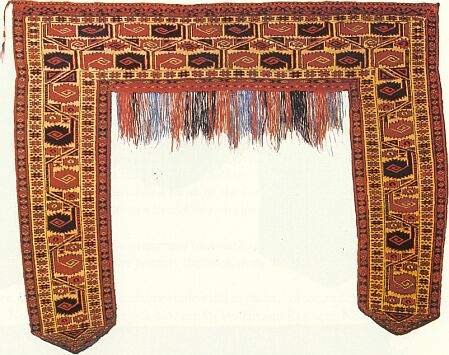
Loges gives its measurements as: 0.88 (0.23) X 1.08 (0.61)
m.
Here is a Chodor version that may be older:
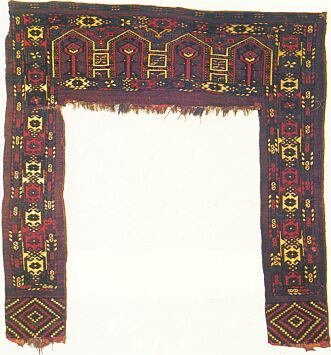
Loges’ measurements are: 1.13 (0.34) X 1.10 (0.21)
m.
This format, it may not put too fine a point on things to specify, is
contrasted with the similarly shaped “khalyk” which is perhaps
one-half to two-thirds as wide and is thought to have been a decoration either
for the breast of the wedding camel or for the (top front?) of bride’s
litter. (There are Yomud "khalyks" that are wider and composed of several such
sections that puzzle the authorities.)
Here are two Tekke khalyks also
from Loges:
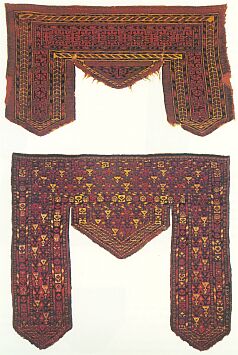
He gives the measurements of the top one as:
0.43 (0.27) X 0.73 m. His measurements for the second one are: 0.4 (0.34) X
0.71 m.
It seems unlikely a kapunuk and an engsi would have been used
together on the inside of the tent door.
Regards,
R. John
Howe
Posted by Robert Alimi on 08-31-2002 09:58 AM:
Hi Ken,
I don't see anything about the design that indicates
felt. But if it _is_ felt, the level of design detail that's observable even in
these photos would make this one heck of an interesting piece of felt work!
Here's an attempt at enhancement using Photoshop's contrast and sharpen
controls:
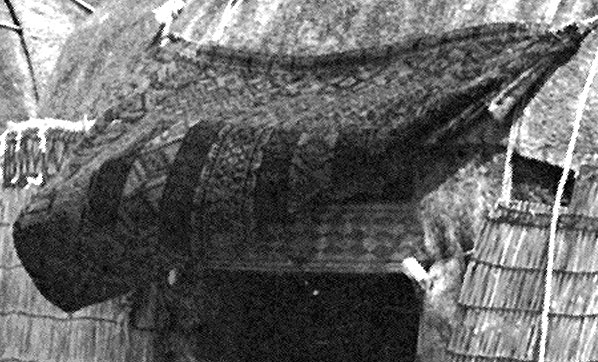
The drape on the left side is strange, but the right side
of the piece doesn't look like at all "poochy" where it is folded under itself.
It'd be most helpful to see a color image. The Prokudin-Gorskii collection
consists of glass plate negatives and contact prints. The LOC has been able to
make some great color prints from the glass plate negatives, but this image
appears to have been scanned from a contact print so it's most likely not
available in the original glass plate negative.
Regards,
-Bob
Posted by Steve Price on 08-31-2002 10:14 AM:
Hi people,
The conventional wisdom, which is right most of the
time, is that felt ensis were used routinely and pile ones were for special
occasions. The fact that we don't have many really old felt ones around is
easily understandable from the fact that they got hard, daily use and looked
awful by the time they were old. Besides, few collectors cared about central
Asian felt until pretty recently, so not many would have been preserved in
collections.
But what did the Turkmen do with pile ensis between
special occasions? Well, using them as internal dividers in the yurt makes
sense, and they were sensible people. So, perhaps the answer to the question,
"Was the ensi a divider inside the yurt or a door flap?" is, "Yes, it was a
divider inside the tent and yes, it was also a door flap
sometimes."
Chuck says he's never seen old ensis in poor condition.
Those don't find their way into books very often, but one dealer at the
Indianapolis ACOR had a Tekke ensi that looked very old to me, and it
was in tatters. I've seen a few others like that, too.
Regards,
Steve Price
Posted by Kenneth Thompson on
08-31-2002 01:42 PM:
Felt or pile Ensi
Dear Bob,
Your Photoshop enhancement does push the surface back
toward the pile option, though I know that there are very fine felts as well.
Thank you very much for keeping the question alive, since this is a crucial
area of doubt.
It would also help if a language scholar could further
identify the origin of the word itself. John's lady who says it comes from
"yengse" or "back of the head/nape," could be right. But I have doubts. In
Turkic languages "en" or "eng" is the way to make a superlative.
"Iyi"="good"."en iyi"=the best. And "en iyisi"="the best of the all" "En" also
is the word for "width" and in Kirghiz "ensiz" means "narrow." It is probably
none of these and may come from a Mongolian source("Egsi" is the Mongol word
for "felt") or even Chinese, about which I don't have a clue. There are
probably a lot of other possibilities.
I mention this abstruse issue
because almost all of the other yurt related words have a functional meaning,
such as kapilik(or kapinik), eshik tish, tegerich etc. It would be odd if ensi,
however spelled or pronounced, did not.
Sorry for such a long
post,
Best regards, Ken
Posted by R. John Howe on 09-01-2002
06:09 AM:
Ken -
I want to correct any impression I may have made that Ms.
Meredova, the Ersari lady, to whom I have referred, suggested that "engsi"
comes from "yengse." She emphatically did not. She merely indicated when I said
I had "my head down" working, that "yengse" means back of the head. She did
then go on to say that most "engsis" in her experience were hung on the inside
of the tent door. But these were separate points. As I have tried to make clear
in a separate thread, Peter Andrews also felt that these two words were not
related but indicated that one must be cautious since neither of them
apparently has an etymology. This was the reason he did some additional
checking.
Just want to make sure that any potential confusion I may have
introduced with my "story" does not persist.
Regards,
R. John
Howe
Posted by Christoph Huber on 09-01-2002 02:16 PM:
Dear all
I would like to add some more pictures of yurts. The
engsis aren’t neither knotted nor Turkmen but I think they are quite
interesting and give additional illustration of Peter Andrews descriptions of
the construction of yurt flaps.
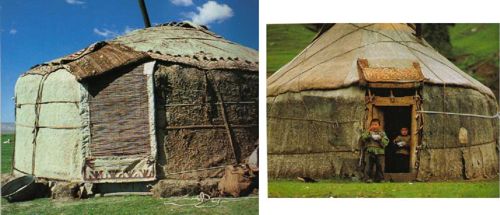
The door of the Kirghiz yurt to the
left consists of two “layers”
- a reed screen with enforced edge
and a decorative felt at the bottom and
- an ornamented felt which is folded
back. (Turkmen peoples, I suppose, on special occasions would have replaced
this felt by a pile knotted engsi.)
The on the Kazakh yurt to right the
similarly decorated reed screen is folded twice (and not rolled as on the
pictures above). The second “layer” (felt or knotted rug) isn’t
attached.
A Karakalpak reed door as well decorated with a panel (most
probably knotted on the open shed) is shown in “Music for the eyes” .
Elena Tsareva, not referring to a specific people, writes that door hangings
were made of knotted textiles, felts, reed screens or a combination of all of
these. They were used according to weather conditions.
It’s
probably a bit off the theme here, but the panels decorating the bottom of the
reed screens look very much like “germech”, don’t
they?
One could argue that the germech-like elems which can be seen on
many engsis have their origin in the panels sewn on the reed screens. If the
engsi would have been folded as seen on the right picture only this part would
have been exposed to the sun and because it’s of a different coloration a
bit of fading wouldn’t do much damage to the aesthetic of the whole
weaving.
And apart from that, if folded this way one can see the whole
(germech-)panel but doesn’t have the impression of seeing only a part of
the engsi’s ornamentation.
Interesting seems to me also this
North-Caucasian Nogaian wedding-yurt .
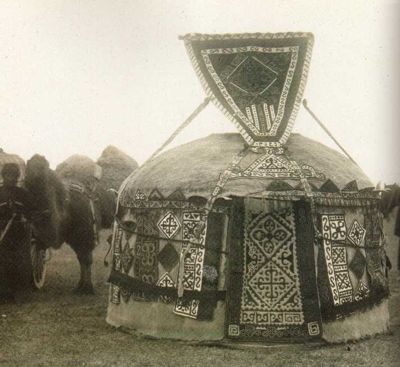
I
believe to have seen a picture of a similar Central Asian “flag/door”
but I didn’t find it anymore...
I also wanted to post in this context
a picture of one these odd-shaped Chodor rugs usually called either prayer rug
or engsi. Maybe someone could help with a reference?
I guess that
pardahs would be a different thing: Azadi shows a striped Yomut rug which he
describes as a pardah. This rug copies flatweave designs and I suppose that
most of the textiles used to divide the yurt were just flatweaves.
A friend
of mine had such a striped Yomut rug which had ropes still attached and so
could support the assumption of its use as a pardah.
On the other hand,
there are also huge main-carpets with ropes, possibly used to secure the carpet
if rolled up?
Marvin, I love your Ersari engsi but according to the
Rietberg Museum, Zurich it’s a Chodor chuval...

Best regards and many thanks for the interesting
salon,
Christoph
Posted by Daniel_Deschuyteneer on 09-01-2002
03:21 PM:
Dear all,
This is somewhat out of topic but as Patrick showed one
example in an earlier thread that got Yon Bard interest I add this picture for
information, showing another Yomut chuval with ropes still atached at the
“closure marks”
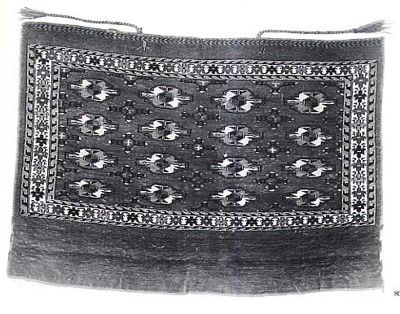
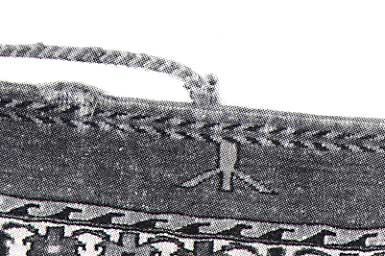
Source is :Teppische aus Mittelasien und Kasachstan
– Exhibition catalog of the Russische Ethnographic Museum Leningrad
Ermitage plate 80
Thanks,
Daniel
Posted by
Daniel_Deschuyteneer on 09-01-2002 05:14 PM:
Dear all,
I add here some pictures coming all from Teppische aus
Mittelasien und Kasachstan – Exhibition catalog of the Russische
Ethnographic Museum Leningrad Ermitage
References of the plates are
included in the name of the jipeg file.
First let me show this picture
from a Khirgiz eshyk tysch. Long ropes attached at each upper corner are still
present.

And here is a close up
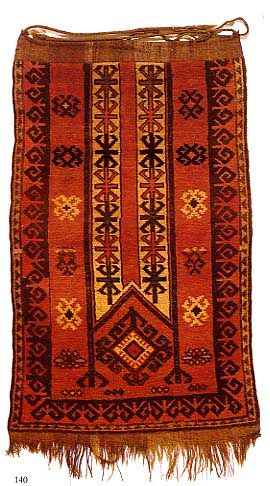
Here is now a Saryk engsi showing both worn upper corners,
a braided fastening band fixed along the top border and the sideway oriented
“candelabra” discussed in another thread.
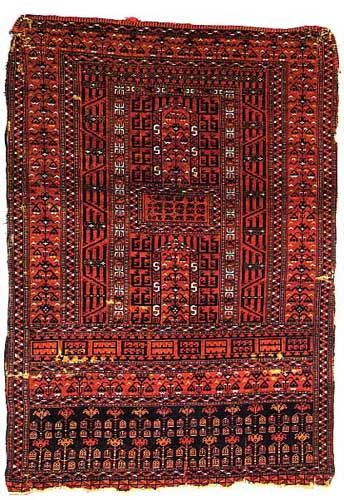
close up of the two color braided band
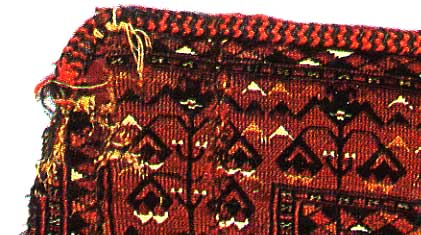
Close up of the sideway oriented
“candelabra”
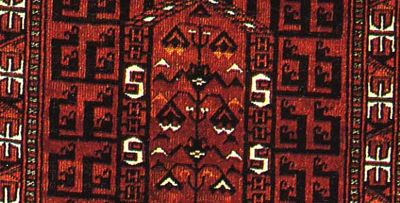
Now let us look at a Tekke engsi showing two colors
braided ropes at each upper corner
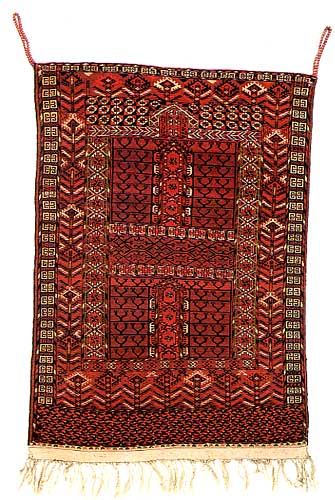
and here a close up
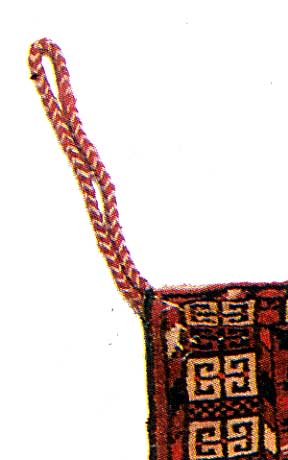
Here is another Tekke rug with another kind of
fastening system. At the base of the ropes there is a (piled?) triangular
stripped reinforcement

You can better see it in this close up
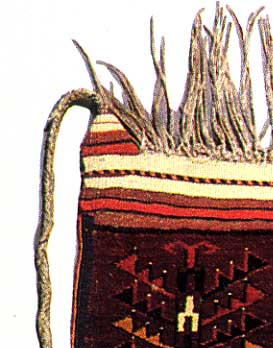
and here are two close up assembled in one picture of the
corners of two Tekke RUGS (not engsi) showing the same construction as on the
upper engsi. This construction is may be typical of Tekke pieces. At least I
didn’t find any other piece that wasn’t Tekke showing this
structure.
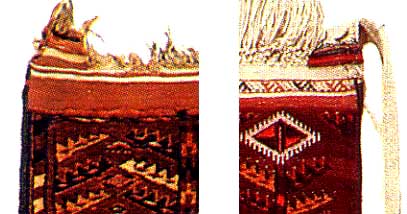
Is the presence of fastening
systems a way to sort pieces which were woven for local
use?
Thanks,
Daniel
Posted by Christoph Huber on
09-01-2002 05:51 PM:
Dear Daniel
The first of the "Tekke rugs" is according to E.
Tzareva an engsi and I would agree with her on this. But it looks very Yomut to
me, not Tekke.
The following rugs are good examples of
Yomut-weavings.
The main-carpet I mentioned in my previous post was a Yomut
as well. There isn’t any pile on these prolonged kilim-stripes which form
the basis of the ropes (at least in the case of the carpet I’ve seen in
the wool).
Best regards,
Christoph
Posted by
Deschuyteneer daniel on 09-02-2002 08:15 AM:
Dear Huber,
You are right the first Tekke "RUG" I show, which is

with the striped weft faced reinforcement at
the base of the rope is an engsi and not a rug and it is presented in the book
as an engsi. I apologize for this mistake.
Best,
Daniel
Posted by R. John_Howe on 09-02-2002 02:11 PM:
Dear folks –
This is a response to Chuck Wagner’s
suggestion that since the Afghan term for “engsi” is
“purdah” and since this latter term is also sometimes used to refer
to the area in which female members of a family (e.g., in the case of a
“harem”) are separated from others in an Islamic home, perhaps one
possible use for the “engsi” might be for such “purdah”
screening in the nomadic tent. Chuck quoted one traveler and visitor to a nomad
tent who reported seeing a carpet used as a kind of privacy curtain.
I
think this is an imaginative suggestion and it seems true that many textiles
that we tend to see as used in singular ways in fact had multiple uses. So I am
not here discounting the possibility that what Chuck suggests may have been in
some cases correct.
Peter Andrews work, which I have been
“mining” liberally in this salon, makes a different
suggestion.
First, in the Yomut community Peter studied first hand, a
newly married couple did not usually live together. After the marriage was
consummated on the wedding night, the bride typically returned to her
family’s home and the couple did not live together for perhaps the first
two or three years of their marriage. About the fourth year, the bride joined
the groom, but again usually the couple does not yet have a tent of their own,
so they live for a time with the groom’s parents. During the initial
period after the bride comes to the groom’s parents’ tent, it is held
to be important that the bride avoid contact with her father-in-law and in fact
most of the more important members of her husband’s family. To provide for
this there is a sequestered area of the tent in which the bride sits. And there
is a cloth used to provide this private space. Here is part of Andrews’
discussion of this aspect:
‘…If a new bride is living with the
bridegroom’s parents, she can sit with her face uncovered behind a
curtain, “tuti,’ of cotton with coloured tags hung on a black and
white rope, “tuti yupi,” stretched across the heads in the same
northwest corner or northern part of the tent where the couple also
sleep…”
Andrews provides a drawing of this sleeping
arrangement that also shows how this rope would be arranged with the
“tuti,” hanging over it.
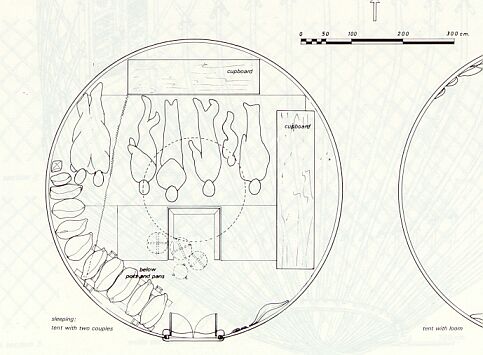
Andrews cites William Irons on the “tuti,” and
in George O’Bannon’s little volume based on what was then Marvin
Amstey’s collection, Irons says, “…The “tuti” was
usually gaily decorated brightly colored strips of cloth, but was not a fine
piece of weaving. It was placed on a rope and arranged so that it could be
pulled back, opening up the area behind it one occasion…”
So
while Chuck Wagner’s suggestion might sometimes have been the case, it
seems that in the Yomut communities that Andrews and Irons studied first hand,
there was a different textile, the “tuti” used to create the
“purdah-like” space in the tent and it seems not to have been a woven
carpet.
Regards,
R. John Howe
Posted by David R.E.
Hunt on 09-03-2002 01:29 AM:
Purdah
Dear R. J.Howe and all- Not that I am a linguist, but it is my
understanding that the term Purdah is Persian and not Turkic, and that It does
refer to a room divider/dividing rug suspended by straps- And to complicate it
even more I have seen some of these large rugs with robust hanging straps being
sold as Purdah-yet with that exploded Mina Khani pattern common to the Ersari
and Beshir, and a vigorous rendering at that! Market influences?
Posted by Christoph Huber on 09-03-2002 06:59 PM:
Dear all
I found the “odd” engsi I’ve mentioned in
my previous post:

“Chodor, Ensi (?)”
Orientteppiche aus Österreichischem Besitz, Vienna, 1986, p.
117
I wonder whether the tapered form only corresponds to the form of
many reed screens used for yurt doors or (less likely?) whether it represents a
knotted version of a “flag/door” as seen in the picture of the
Nogaian wedding-yurt.
Best regards,
Christoph
Posted by
R. John Howe on 09-20-2002 07:14 AM:
Width: One More Time
Dear folks -
Just when you might think we've finished with this
thread, I have found a reason for one more post here about door
width.
Yesterday, while visiting the Textile Museum library, I also
peeked in at their upstairs gallery where they've been responding to frequent
calls to make Meyers' collection more accessible by putting up pieces from it
under different themes.
The current theme is the use of silk in rugs
and textiles and one piece they have is an older Turkman door surround with
sumptious silk decoration in places. This piece is in good condition and seems
likely to have been used only on a special occasion basis.
One is not
allowed to touch exhibited items at the TM but I could get my hands close
enough to determine that the opening in this piece is just about three of the
lengths of my hand wide. My hand is almost precisely 20 cm long and so this
opening is only about 60 cm wide. People would definitely have brushed this
piece at the sides as they went and out (I am a sizable person but my shoulders
are about 65 cm wide), but the external width of it is less than
120cm.
Regards,
R. John Howe
Posted by Kenneth
Thompson on 09-20-2002 12:12 PM:
Purdah in Turkish usage
Dear David,
In Turkish, "perde" is the standard word for a
curtain. Turkish has for a long time been heavily laced with Persian words.
Following Ataturks reform of the alphabet, there has been an effort to
substitute "pure" Turkic words--words from Central Asian languages--for words
of Arabic, Persian, and even English derivation. The effort has partially
succeeded, but you often have to learn two or three words for the same thing,
since they can appear at random in publications or even on road signs (eg,
"tamir" and "onarim" both indicate a road under
repair.)
John,
Peter Andrews published a picture of a tuti
somewhere, but I can't find it. It looks like a bedsheet with rows of
good-luck/apotropaic tassels all over it.
Regard to all,
Ken
Posted by Sue Zimerman on 09-20-2002 07:54 PM:
Dear John,
Did to silk in the TM Turkman door surround come from
Europe, the Caspian area, or China? Sue
Posted by R. John Howe on
09-20-2002 09:50 PM:
Sue -
Well, of course, there's no way of knowing in a particular
instance but there was silk production in Central Asia in some of the areas in
which the Turkmen with the engsis and door surrounds lived. Bukara was not only
a major marketing outlet for Turkmen weavings, it was one city in which the
suzani and ikats were made. And the Ferghana valley had a silk production even
larger than Bukara's and even exported silk to East Turkestan. Suzani designs
are embroidery in silk and were sometimes done on a silk ground. Ikats designs
are made with silk warps. So the fact that there is silk decoration on some
Turkman pieces (and it was sometimes lavishly used in pile areas) is likely the
result of local silk production, not imported silk.
Regards,
R.
John Howe
Posted by Sue Zimerman on 09-21-2002 12:14 AM:
Dear John,
I would like to know where, in fact, the silk came
from. Silk was also being produced in Europe through the 18th century. Georgia
and even Greece were producing silk well into the 19th century. It could have
been brought to the Turkmen with dye from Germany or otherwise, too. Someone
should know this, shouldn't they?
We have a lot of things here in the US
produced locally that we buy from China. If we want to know influences we
should know what influences they were exposed to. If there are facts available
I think they should take precedence over conjecture. Don't you? Sue
Posted by R. John Howe on 09-21-2002 06:37 AM:
Sue -
I agree that factual data is always preferrable to
conjecture, but it's going to be difficult to determine where silk in a given
Turkmen piece came from at least until they develop far more fully the
techiques that permit one to tell such things from the dyes and from the
wools.
And the Turkman lived close to, if not directly on, what is
famously called "The Silk Road," and likely for a reason. So imported silk is
always a possibility.
Despite this, the fact that it is also known that
there was vigorous local silk production in the areas where the Turkmen lived
(cotton too) to the extent, in the case of the Ferghana valley, that they
actually exported some in the direction of China, (the treatment silk
production in Bukhara in the catalog by Andy Hale and Kate Fitz Gibbon on the
Goldman ikat collection is extensive) seems to me to provide a pretty sound
basis for thinking that the silk in Turkmen carpets is mostly of local origin.
Turkomaniacs have examined all kinds of arcane features of their beloved rugs
since the 1970s at least and I've not heard someone raise this question
before.
And I'd don't know how you'd determine its answer for a given
Turkmen piece.
Regards,
R. John Howe
Posted by Sue
Zimerman on 09-21-2002 12:53 PM:
Dear John,
I am not asking out of idle curiosity. I am doing a
lot of research to discover the answer to a question raised by my last
research. A German connection would defiantly answer this question once my new
research is applied to it. If there is no German connection resolution will be
more difficult, but the new information will be illuminating nonetheless. I am
in the process of cleaning it up for posting.
Can you, or can anybody
else, clarify the approximate time frame of old, middle and late engsis? Unless
I have missed it, I cannot find this information in this salon.
I have
read the shamanism thread. There is one thing I want to clarify now. Please
don't think that my suggestion that the Hatchli pattern could represent the two
phases of the Milky Way's appearance at migration times is exclusionary. I
believe Jourdan's suggestion is valid. I also think the Hatchli pattern is a
door and a garden, too. What I am suggesting is that there is another level of
concrete meaning woven into it which allows for it to be more than a two
dimensional representation. I think that the design encompasses a third axis
which allows it to be viewed as more than a schematic.
A "Milky Way's eye
view" requires of the viewer to mentally pull the upper cross bar into the
heavens and push the lower cross bar to the opposite side of the earth. Once
this is accomplished the viewer can see the "sky map" with the vastness
analogous to that which is portrayed in western art by means of three point
perspective. In other words I think that the illusion of space is not, as we
have been taught in the West, a Renaissance invention, but a western
translation. Clear? Sue
Posted by Steve Price on 09-21-2002 01:20
PM:
Hi Sue,
I can respond to the part of your post that asks about
the ages of ensis. In my opinion, the oldest ones we have were probably made
around 1800, give or take 25 years. Most antique ensis were made in the last
quarter of the 19th century. Those made later aren't antiques, and, in any
case, a very large number were made for sale to the west after 1875 or
so.
Does everyone agree that the oldest ones are late 18th/early 19
century? No. There is a school of thought, to which I do not subscribe, that
there are Turkmen textiles around that date back to the 15th century. Those who
believe that, probably also believe that a significant number of ensis predate
the 18th century. The people in that group, by and large, have old Turkmen
textiles for sale.
Regards,
Steve Price
Posted by
Sue Zimerman on 09-21-2002 02:20 PM:
Dear Steve,
Thanks! That helps. Sue
Posted by Yon
Bard on 09-21-2002 03:11 PM:
Steve, you made the following remark:
"Does everyone agree that
the oldest ones are late 18th/early 19 century? No. There is a school of
thought, to which I do not subscribe, that there are Turkmen textiles around
that date back to the 15th century. Those who believe that, probably also
believe that a significant number of ensis predate the 18th century. The people
in that group, by and large, have old Turkmen textiles for sale."
If
this isn't ad-hominem, I don't knoe what is. Ii is OK to contest the carbon 14
datings on scientific grounds, but not by imputing base motives to their
promulgators.
Sue, when you theorize about the meaning of the ensi
patterns, do you think the individual weaver had these things in mind, or just
that that's how the pattern was originally developed? I am sure it is fun to
"see" things and speculate about their meaning and origin, but please be honest
and tell us what you really think is the likelihood that your particular
interpretation is the correct one.
Regards, Yon
Posted by
Steve Price on 09-21-2002 05:20 PM:
Hi Yon,
As you know, I am skeptical about the reliability of C-14
dating as applied to oriental rugs made within the past 400 years or so. I
believe the statements in my post are true, and I was very careful NOT to say
that the people who believe differently than me are frauds who are
misrepresenting the stuff they have for sale. If anyone cares, I think some are
and some aren't, but I can't read minds any more than anyone else can and my
opinions of their motives are irrelevant.
It is a fact that most of the
people who profess that there are Turkmen pieces around that are more than 300
years old are those who are trying to sell those pieces. It is also a fact that
almost nobody can be totally objective about a piece in which he has a
financial interest, particularly a large financial interest, particularly when
he makes a living from it. So, their opinions on this matter, whether sincere
or bogus, contain a source of bias. That bias may well be subconscious, but the
question of whether there are 400 or 500 year old Turkmen pieces has
consequences for them. It is inconsequential to me, and to most of
us.
This, of course, is exactly why we don't permit discussion of items
that are on the market. Objectivity, difficult to attain for almost anything,
is even more difficult by orders of magnitude when there are financial
interests involved.
This is ad hominem to the extent that it recognizes
that we are humans and that this is human nature. It was not an attack on
anyone's character, intelligence or motives.
Regards,
Steve
Price
Posted by Sue Zimerman on 09-21-2002 07:11 PM:
Dear Yon,
The weaver would have to know what the symbols mean.
She would have to know the "grammar", how to put the "words" into "sentences".
I don't think she would have to know deeper meanings than the concrete ones or
where they originally came from. She would have to know the story and how to
tell it.
The only reason I'm telling what I see is that the symbols seem to
be obsolete. If they were not I would have to consider who am I working for?
The code value for symbols is enormous. They can be used for evil. I want no
part of that sort of thing. I am too squeamish to look at the new rugs. I have
just checked them to make sure the ones I'm studying are not used anymore. More
than what you asked but important to say.
I am just following the
direction the Engsi is leading me, and offering my findings as I go. I wouldn't
do this if I wasn't convinced it was real, and could lead me to what I should
be looking into next. It has lead me to history, not my cup of tea at all, but
it is panning out.
It doesn't mean I'm right that I have probably spent
more time looking at this sliver than it took to weave, and probably more time
than anybody else on the planet has, but it does say something toward my belief
it has something to say. So, yes, I think that what I have said up to now about
it is correct -- not that what I have said is the whole picture.
I
haven't seen enough close ups to work out the planets yet but I have worked out
many other symbols. There are symbols which represent more than one thing, just
as there are words that do, which will take more time to know.
I think I
should be cut some slack. Engsis have been around a long time without being
deciphered. I only began this when this salon started.
Dear
Steve,
Since the subject has been raised, perhaps it is just my bias,
but those things called "smiles" add absolutely no clarity to what is meant in
a post and are offensive, ugly, and not funny. They hurt my eyes. Sue
Posted by Steve Price on 09-21-2002 07:43 PM:
Hi Sue,
The smilies are also known as "emoticons", which more
nearly expresses what they're about. They are widely used on web discussion
boards and even in e-mails to try to convey what is conveyed in face-to-face
conversation by body language, facial expression and tone of voice - the
unspoken messages sent by your emotions. None of those things is possible in a
purely written venue, at least, not without getting terribly verbose. Many
venues that don't use emoticons use other commonly understood shorthands for
the same purpose; stuff like LOL (laughing out loud), ROFL (rolling on the
floor laughing), and making sideways faces out of the colon, hyphen, and
various forms of brackets in different combinations.
Obviously, they add
to the enjoyment some people get from using these boards, and there are some
who use them in ways that I think are creative and inoffensive (I'm thinking of
Vincent Keers here). On the other hand, we don't think ugly or offensive are
good things to be, and I guess I have to take you at your word when you say
that they hurt your eyes, although I find it hard to understand that part.
I'd like to get other peoples' feelings on those things before taking
any action. Would you open a new thread on our Miscellaneous Topics section
soliciting opinions on this?
Thanks,
Steve Price
Posted by Filiberto Boncompagni on 09-22-2002 02:31 AM:
Hi Sue,
In other words, smilies/emoticons are nothing else than
modern SYMBOLS. And their good side is that they cannot be used for
evil.
Regards,
Filiberto
Posted by Sue Zimerman on
09-22-2002 12:07 PM:
Dear Filiberto,
If you are saying that modern symbols are simple
and shallow, I disagree. Sue
Posted by Steve Price on 09-22-2002
12:33 PM:
Hi Sue,
Filiberto didn't say anything about the depth or
simplicity of modern symbols, only that smilies are part of that group. Nor did
he say that this subcategory of modern symbols is simple and shallow. Indeed,
some people react to them much more strongly than I would expect if these were
shallow symbols.
Regards,
Steve Price
Posted by Sue
Zimerman on 09-22-2002 12:43 PM:
Dear Steve,
I've go to step out of this Chinese trick box and
back to work on my evidence that you won't buy. Time is a tyrant. Ta Ta,
Sue
Posted by Chuck Wagner on 09-22-2002 04:38 PM:
I see, said the blind man as he picked up his hammer, and
saw...
Hi All,
First, go back to Bob Alimi's post in this thread of
8/31/02 2:08, which shows
an enhanced view of a pile weaving used as a door
flap on a yurt.
Then, look the new edition of Eiland & Eiland's
Oriental Carpets:
Page 232, plate 206: A 19th century Tekke
ensi
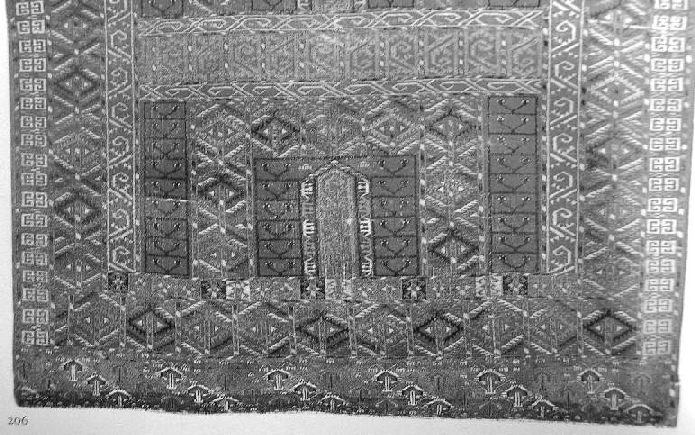
It MIGHT even be the same rug...
Regards,
Chuck
__________________
Chuck Wagner
Posted by Yon Bard on 09-22-2002 05:07 PM:
Chuck, great similarity, but the bottom-most panel (topmost in the yurt
picture) are different.
Thanks for putting in an append that actually
deals with rugs.
Regards, Yon
Posted by Robert Alimi on
09-22-2002 06:19 PM:
For the sake of convenience, here's another view, this one flipped 180
degrees.
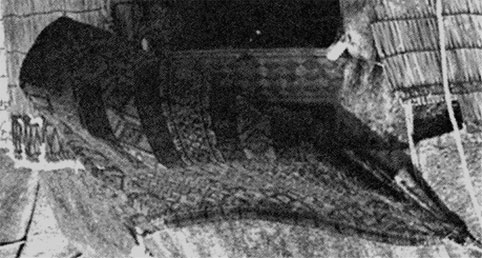
Also, several of Pinner's quotes regarding
engsis have been mentioned during the salon, but I don't recall his "Atlantic
Collections" quote having been posted before. For what it's worth, here it is
(from pg 173):
"The ensi is a door hanging with the design displayed
outwards from the yurt. That its use was confined to the Turkmen wedding
ceremony and perhaps for other special occasions, is supported by the fact that
its colours rarely show the fading which would follow prolonged exposure to
sunlight."
I think he's got it right.
Regards,
-Bob
Posted by Sue Zimerman on 09-22-2002 08:22 PM:
Dear Yon,
Pardon me for taking the time to try to thoughtfully
answer the rug question you asked me. It won't happen again. Sue
Posted by Yon Bard on 09-22-2002 09:07 PM:
Sue, please forgive me. I am becoming cantankerous in my old
age.
Regards, Yon
Posted by Sue Zimerman on 09-23-2002 05:43
AM:
Dear Yon,
I understand, I forgive you.
Has anyone else
noticed that the 1885 yurt drawing in John's opening essay has curtains drawn
to the sides which could be pulled down, like the yurt's in the background, to
protect the engsi from sun damage? Sue
































